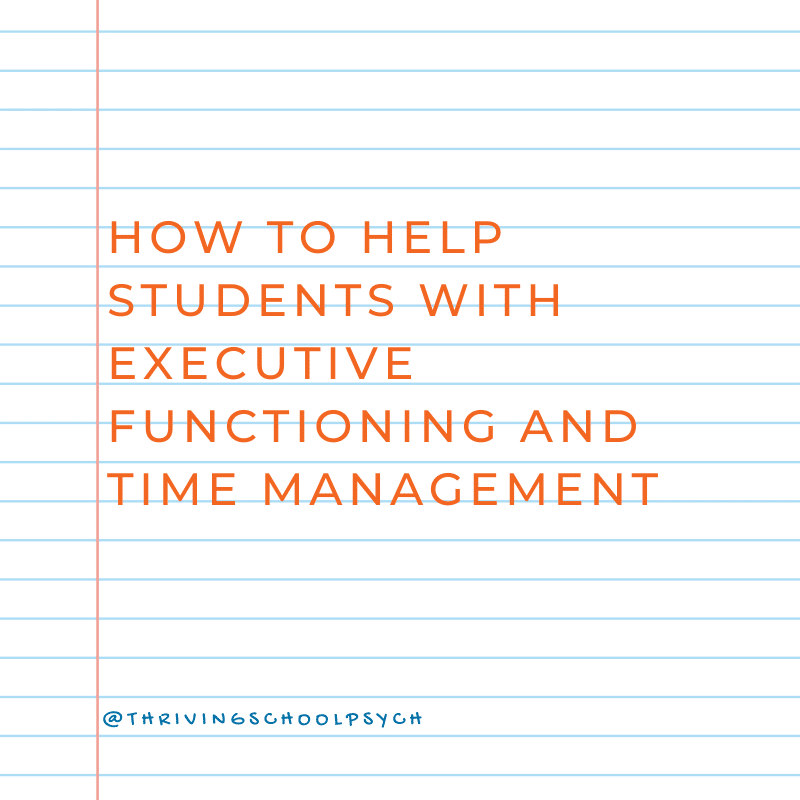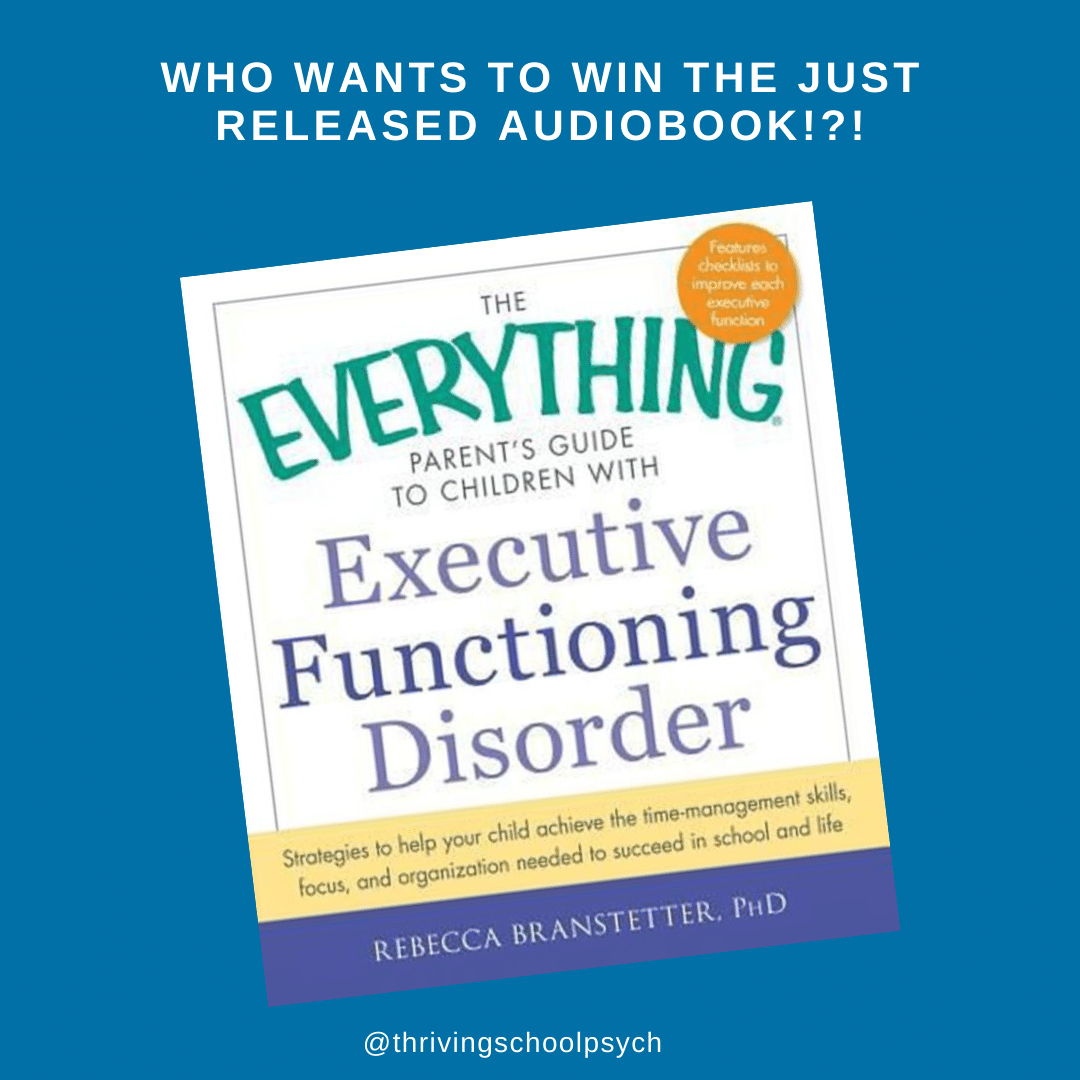
Teaching Executive Functioning and Time Management at Home and School
As we start the second month of 2020, I just wanted to check in with all of you about something that’s seemingly random, but is actually related to our job as school psychologists. How many of you out there are not just school psychologists, but parents who are school psychologists? I don’t know about you, but as a school psych parent, I definitely try to unleash my school psychology tools upon my children – sometimes it works, and sometimes not so much! 🤣 If you’re in the same boat, I wanted to share with you one thing that I’ve found does work in terms of building executive functioning skills using time management at home.
And these strategies not only work at home for parents, but also in the classroom. As school psychologists, we’re constantly talking with teachers about kids who display difficulties with time management – the kids who don’t have the same sense of time as everyone else. Watch this 6-minute video to learn about how to teach the executive functioning skill of time management.
When you’re done with the video, be sure to comment with your favorite tip or tool for teaching executive functioning skills. My Thriving School Psychologist Collective online course members and alumni and I are cooking up a cool new resource together and need your help!
Helping Students with Challenges with Time Management
Have you noticed that sometimes kids with Executive Functioning challenges or ADHD seem to only have two time zones – either “now” or “not now”? If it’s not now, it becomes “I’m good, I don’t need to do it” then suddenly it becomes “Oh my gosh, it’s now! Panic!” There are a lot of students who operate like that – the assignment isn’t due right now, so they put it off and they put it off because they don’t really understand that sweep of time, or they squander the first 20 minutes of a work period, and then suddenly find they have to rush to finish.

So, building in executive functioning skills with time management is something that I’m working on at home with my own kids, as well as something I’m consulting with teachers about. One of the things that I want to teach you is just a real quick tip for teaching time management, which comes from Sarah Ward. I did a coffee chat with her for my Thriving School Psychologist YouTube channel, and she shared some other really practical strategies for teachers, but I particularly wanted to share this one with you.
For this exercise, you’ll need an analog clock, and let’s say I needed to get my kids out of the house for school by 9:00. I have time blocked out on the clock to get shoes on, then another block for backpacks, and the last thing I have is a block allotted for is getting into the car because if I say at 9:00 “Hey guys, it’s time to get in the car,” we don’t get in the car in time because kids don’t really understand how much time it takes to get in the car AND the steps or tasks that need to be done in order for us to be ready to go to school and lead up to us getting in the car.
This is a trick that’s been a game changer in my mornings because I say, “Okay, it’s time to go, it’s time to go, it’s time to go,” but little ones don’t have a real sense of time or understand what it means to “be ready in five minutes” or 10 minutes. Adding to the issue is that the sound of my voice saying “it’s almost time, it’s almost time, oh my gosh, IT’S TIME!” can be stressful for both me and my kids. So what I’ve ended up doing is just pointing to the analog clock with the tasks in blocks and being like, “Hey guys, look where the clock is,” and they’re like, “Ah, it’s shoe time,” and it’s no longer a feeling of “now” and “not now.” It builds the “sweep of time.” Sarah Ward talks about this sweep of time concept and that the problem with digital clocks is that they only have the now and not now. On a digital clock, if it’s 7:55, it’s not 8:00, and so how do kids who struggle with this understand that sweep of time?
Along those same lines is the clock concept that teachers can use in the classroom. What they can do is draw on a clock with a dry erase marker to fill in the blocks of time they have for their assigned activities – like “If recess is at 9:00, take a look at this clock and see how much time we have left to put away our things,” or whatever it is that they’re trying to transition to. It builds in an understanding of the sweep of time so that kids can understand that time passes.
A lot of teachers (and I actually used to do this when I was working with students doing executive functioning coaching) use countdown timers which is an “almost time, almost time, almost time,” model, but that’s not really how time works. Time marches forward on clocks, not backward, so if we can teach kids (both at school and at home) using an analog clock and help our teachers understand the sweep of time concept, then we’re going to be better able to coach them up on teaching executive functioning skills.
Crowd Sourcing your Awesome Tips and Strategies to Build Kids’ Executive Functioning Skills
You are all in the classrooms and you do a lot of observations, and you’re probably observing some really wonderful teaching strategies. And because we are often our own best resources, I want to do a follow up “crowd sourced blog post”, which is to ask you two things:
1) Do you have any quick tips or strategies that you’ve seen that help build executive functioning skills in children?
2) What is your favorite tip for teaching kids any of the executive functions (e.g. time management, organization, impulse control, etc.)?
These tips could include something that a teacher uses or something that you use when you’re working with children and adolescents on building out executive functions like time management, organization, self-regulation, impulse control, task initiation…anything!
So before I sign off, I want to give you a little commercial about the importance of building a repertoire of easy to teach, easy to consult with executive functioning strategies for teachers.
The reason that I’m doing a little bit of a shoutout is because in the Thriving School Psychologist Collective online course we pick a topic or theme that we work on behind the scenes. One year we picked doing a PowerPoint presentation for School Psychologist Awareness Week, in which we highlighted the ways that school psychologists contribute in ways other than testing – and that was widely downloaded and used during SPAW.
One of the things that is percolating for us right now when we’re doing our Zoom video calls together and when we’re on our private Facebook forum, is “How do I help support teachers in teaching executive function skills in the classroom?” This is what this project’s all about and I really can’t wait to hear from all of you school psychologists out there as to what you see working for teaching and reinforcing executive functioning!
So that’s our time for today (did you see what I did there?). Let’s crowd source and share the most awesome executive functioning teaching strategies (type yours in the comments!) I can’t wait to geek out with you on all things executive functioning!

I am a teacher who would LOVE to learn from gathered best practices!!
I love the clock strategy! For younger children, you can even use clip-art/pictures to represent shoes, car, etc!
And this is a strategy I teach to students in 5th grade and older: I guide them in creating a “Do I have…” checklist for their cubby/locker. The list contains 3 items/materials that they are likely to forget to take home with them at the end of the school day. I tell them that the items may change throughout the year and I check in with them periodically about whether this tool is helping. I also tell them that maybe one day, they may not need the list at all. We discuss how it may also be helpful to have a list at home for what they need to remember to bring to school in the morning.
@Helayna. I love this!!! It’s so smart to rotate the items so they don’t become background they no longer notice. 🙂